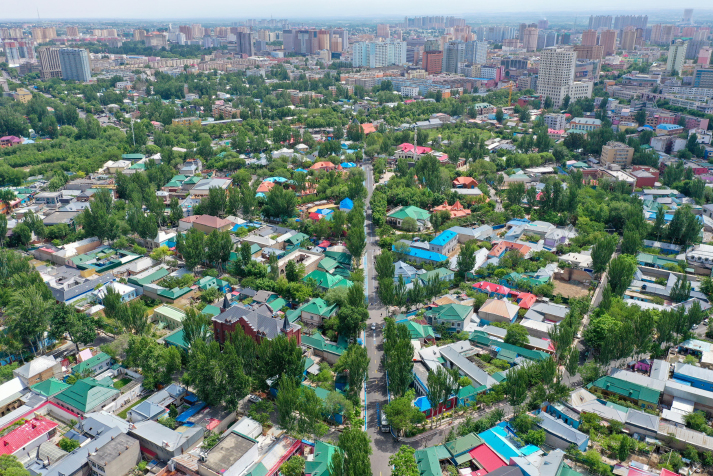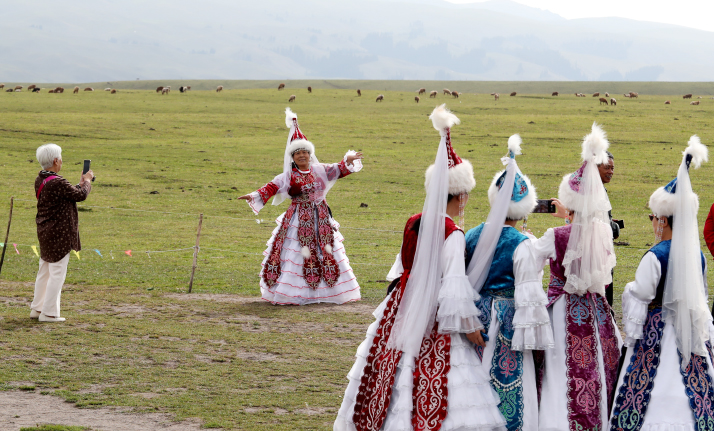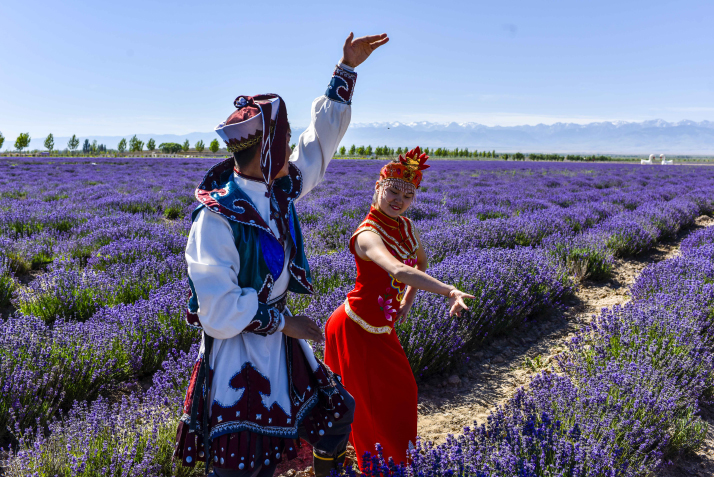| Xinjiang Today |
| Finding Xinjiang's spirit | |
|
|
 The Liuxing Street in Yining, Ili Kazak Autonomous Prefecture, features a unique hexagonal layout designed by a German engineer and built in the mid-1930s (XINHUA)
Two visitors recount their journeys across Xinjiang. They outline how it offered more than sights and sounds but also revealed a living dialogue between history and modernity. From the bazaars of Kashi (Kashgar) to the lavender fields near Sayram Lake, they encountered a region alive with culture, resilience and the promise of shared future.
 Tourists pose for photos wearing traditional Kazak attire in the Nalati (Narat) Grassland in Ili on August 24 (VCG)
Rajendra Prasad Rimal, a deputy editor at Janata Weekly in Nepal There is a Nepali saying I grew up with: "What you see with your own eyes is undeniable compared to what others tell you." My recent 10-day journey through Xinjiang made that wisdom ring truer than ever. For years, I carried the same mental picture many outsiders have of Xinjiang—a vast, barren desert, a place left behind by modernity. What I encountered instead was a landscape and society transformed, alive with cultural diversity, economic vitality and infrastructure rivaling that of the world's most advanced regions. Even before my plane touched down, the view below shattered my expectations. Highways stretched across the desert, flanked by enormous solar farms and wind turbines, turning sand into energy and opportunity. Xinjiang, often portrayed as remote, felt instead like a frontier of possibility—where modern development meets ancient landscapes. The natural beauty alone was breathtaking. Sayram Lake in Bortala Mongolian Autonomous Prefecture, more than 2,000 meters above sea level, glistened like a sapphire ringed by mountains. Once called a "fishless" lake, it now thrives with life, attracting visitors from across China and beyond. The Kalajun Grassland in the Ili River Valley rolled endlessly under a wide blue sky, its beauty rivaling the world's most renowned natural wonders. Walking there, watching families picnic and horsemen gallop across the meadows, I felt both the timelessness of tradition and the promise of tourism-driven prosperity. But Xinjiang's story is not written in its landscapes. It lives in its people—farmers, entrepreneurs and artists whose lives reflect a broader transformation. In Huocheng County, I visited a dairy startup founded by two young women who turned a small family operation into a thriving enterprise. Their story is not unique; across the region, cooperatives and youth-led businesses are breathing new life into rural communities. The resilience of farmers raising camels on the desert's edge or cultivating lavender and goji berries—also known as wolfberries—illustrates how government-supported initiatives and individual ingenuity work hand in hand. What struck me most was the harmony of cultures. In the streets of Yining City, I heard multiple languages, saw mosques alongside modern shops and watched Kazak dances performed near bustling marketplaces. Far from the fractured image often painted abroad, Xinjiang revealed itself as a tapestry of coexistence. A local told me, "Here, diversity is not just about identity—it is our daily life." His words lingered with me. This cultural richness is carefully preserved. The Kazak Cultural Tourism Center, art troupes keeping the music of the Silk Road alive and traditional hospitals that integrate ethnic knowledge into modern medicine all speak to a determination to safeguard identity while embracing progress. In Urumqi's International Grand Bazaar, I could sense the legacy of the Silk Road while witnessing a thriving hub of trade and tourism connecting past and present. Xinjiang's development is no accident. The region has benefited from significant infrastructure investment, from highways and railways to international expos linking it to global markets. Beyond economic growth lies an even greater achievement: stability. Counter-terrorism efforts, community security programs and inclusive development policies have created space for ordinary people to live, work and dream without fear. The results are visible—lively streets, flourishing businesses and vibrant cultural events. The contrast between perception and reality could not be starker. To many outsiders, Xinjiang is a place defined by headlines and assumptions. To those who walk its streets, meet its farmers or share tea in its bazaars, Xinjiang is something far more tangible—a region where cultures blend, economies grow and traditions endure. As I left, I found myself returning to that Nepali proverb. What I had seen with my own eyes was undeniable: Xinjiang is not a land of desolation, but of opportunity and resilience. It is a reminder that to truly understand a place, you must go there yourself.  A Xibe ethnic dance is performed on a lavender farm in Chabuchaer Xibe Autonomous County, Ili (XINHUA)
Elham Sadat Mirzania, an Iranian lecturer in the Chinese Language Department at Toronto Metropolitan University in Canada It was a great honor for me to take part in the event named China in the Eyes of Sinologists: A Cultural Tour in Xinjiang. As a scholar who has spent many years translating Chinese literature and engaging in Sinology, I have long believed that words are more than language—they are vessels of memory, history and emotion. Through translation, Chinese voices travel across borders, opening windows for cultural understanding and cross-civilizational dialogue. I have translated the writings of renowned Chinese authors for international audiences. Among them, famous Chinese writer Wang Meng's Scenery on This Side—a long novel written in the 1970s and set against the backdrop of rural Xinjiang—holds a special place. As I rendered his novel into Persian, I felt as if I were walking through Xinjiang's mountains and markets, its deserts and rivers, guided by his words. And this journey allowed me to finally connect the text with reality. Visiting Wang Meng's study in person deepened my appreciation, bridging literature with lived experience. Traveling across the region, from the bustling bazaars of Kashi to the open grasslands of Ili, I witnessed the vibrant diversity that defines this region. In Kashi's ancient city, I was struck by the fusion of tradition and modernity. The streets were alive with music, color and trade. At the same time, I also sensed an infusion with an entrepreneurial spirit. I was especially moved by the sight of women running cultural shops and handicraft workshops. Their economic independence not only transforms their lives but also creates opportunities for their communities. It is a quiet yet powerful story of empowerment and resilience. In the Xibe Ancient City of Chabuchaer, also known as Qapqal, I encountered a community fully dedicated to preserving its heritage, where traditional crafts and customs vividly showcase the enduring spirit of the Xibe people. From language and traditional attire to archery and music, the Xibe people embody the richness of China's ethnic mosaic. Their commitment reminded me that cultural survival is not passive—it is an active choice, one that adds vibrant threads to the fabric of the nation. Similarly, walking along Liuxing Street in Yining City, once a hub of Silk Road exchange, I could feel the echoes of coexistence and dialogue—threads of an ancient tapestry—that have continued to shape Xinjiang for centuries.
The beauty of Xinjiang is not only cultural but also environmental. At Sayram Lake, a jewel of clear blue set high in the mountains, I watched families gather by the shore, while lavender fields stretched across the horizon. These landscapes are more than scenic; they represent Xinjiang's embrace of green development and sustainable tourism. They serve as a reminder that progress and preservation can develop hand in hand. For me, this journey carried personal weight. My homeland is currently in conflict, and my heart often feels heavy. Yet, in Xinjiang, the kindness of strangers, the solidarity among communities and the resilience of daily life brought me comfort. It offered a glimpse of what peace and cooperation might look like when people pick harmony over division. The rich culture, warm people, colorful attire, soulful music and unforgettable cuisine of Xinjiang left an enduring impression on me. These are not just memories, but lessons and stories I will share with my students, colleagues and fellow Iranians. In doing so, I hope to carry forward the spirit of cultural exchange, ensuring that Xinjiang is not seen through secondhand narratives but through the eyes of those who have truly walked its streets. Comments to zhaowei@cicgamericas.com |
|
||||||||||||||||||||||||||||||
|